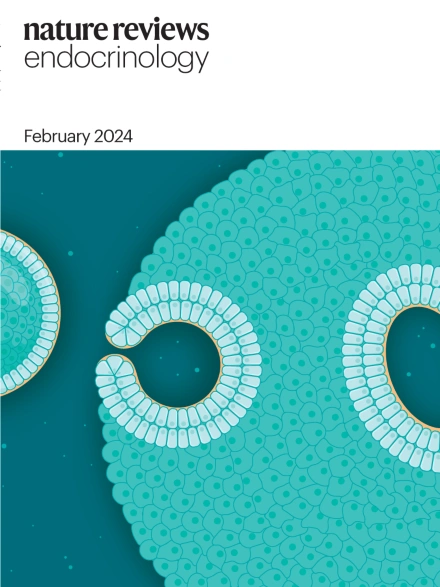皮肤神经免疫内分泌学:环境如何调节机体平衡
IF 40
1区 医学
Q1 ENDOCRINOLOGY & METABOLISM
引用次数: 0
摘要
包括皮下组织在内的皮肤是人体最大的器官。表皮是最上层,与环境直接接触,并暴露于环境应激因素,包括太阳辐射和生物、化学和物理因素。这些环境因素触发皮肤内的局部反应,调节皮肤和全身水平的稳态。皮肤内的免疫和神经内分泌系统使用与脑通路相同的介质调节这些反应,以激活各种信号转导通路,并以上下文依赖的方式影响全身内分泌和免疫系统。这种皮肤神经-免疫-内分泌系统是通过表皮、真皮、皮下和附件调节单位的形成而划分的。这些单位可以单独或协同作用,以保持皮肤的完整性,允许适应不断变化的环境,并防止病理过程的发展。通过激活周围神经末梢,将神经递质、激素、神经肽、细胞因子和/或趋化因子释放到循环中,或通过启动循环和常驻免疫细胞,该系统影响中枢协调中心和全局稳态,从而调节机体的稳态和异稳态,以最佳地应对不断变化的环境。本文章由计算机程序翻译,如有差异,请以英文原文为准。


Neuro–immuno–endocrinology of the skin: how environment regulates body homeostasis
The skin, including the hypodermis, is the largest organ of the body. The epidermis, the uppermost layer, is in direct contact with the environment and is exposed to environmental stressors, including solar radiation and biological, chemical and physical factors. These environmental factors trigger local responses within the skin that modulate homeostasis on both the cutaneous and systemic levels. Using mediators in common with brain pathways, immune and neuroendocrine systems within the skin regulate these responses to activate various signal transduction pathways and influence the systemic endocrine and immune systems in a context-dependent manner. This skin neuro–immuno–endocrine system is compartmentalized through the formation of epidermal, dermal, hypodermal and adnexal regulatory units. These units can act separately or in concert to preserve skin integrity, allow for adaptation to a changing environment and prevent the development of pathological processes. Through activation of peripheral nerve endings, the release of neurotransmitters, hormones, neuropeptides, and cytokines and/or chemokines into the circulation, or by priming circulating and resident immune cells, this system affects central coordinating centres and global homeostasis, thus adjusting the body’s homeostasis and allostasis to optimally respond to the changing environment. The skin is not only a physical barrier between the body and the environment but also contains neural, immune and endocrine factors acting together to respond to external stimuli. This Review discusses the role of the skin as a neuro–immuno–endocrine organ and its influence on whole-body homeostasis and allostasis.
求助全文
通过发布文献求助,成功后即可免费获取论文全文。
去求助
来源期刊

Nature Reviews Endocrinology
医学-内分泌学与代谢
CiteScore
42.00
自引率
0.70%
发文量
158
审稿时长
6-12 weeks
期刊介绍:
Nature Reviews Endocrinology aspires to be the foremost platform for reviews and commentaries catering to the scientific communities it serves. The journal aims to publish articles characterized by authority, accessibility, and clarity, enhanced with easily understandable figures, tables, and other visual aids. The goal is to offer an unparalleled service to authors, referees, and readers, striving to maximize the usefulness and impact of each article. Nature Reviews Endocrinology publishes Research Highlights, Comments, News & Views, Reviews, Consensus Statements, and Perspectives relevant to researchers and clinicians in the fields of endocrinology and metabolism. Its broad scope ensures that the work it publishes reaches the widest possible audience.
 求助内容:
求助内容: 应助结果提醒方式:
应助结果提醒方式:


